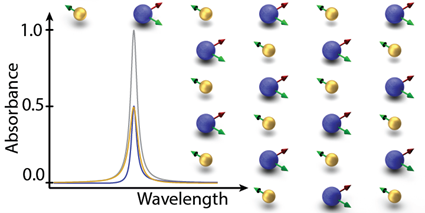Perfect absorption with overlapping electric and magnetic lattice resonances in periodic arrays of metalloelectric nanostructures
- A two-dimensional arrangement of electric dipoles or magnetic dipoles cannot absorb more than half of the incident light power.
Madrid / January 29, 2024
A team formed by researchers from the Theoretical Nanophotonics group of the Institute of Optics has published in the journal Advanced Optical Materials an innovative solution to effectively overcome the inherent limitation of purely two-dimensional arrays of nanostructures supporting lattice resonances that cannot absorb more than half of the light incident on them.
Latest News
Researchers have demonstrated a new design that achieves complete light absorption by using metallodielectric arrays that simultaneously and independently support electrical and magnetic lattice resonances. Lattice resonances are collective electromagnetic modes that light can excite by interacting with periodic arrays of nanostructures distributed on a two-dimensional surface. These modes originate from the mutual interaction between the resonance modes of each of the individual particles forming the array. Lattice resonances allow arrays of nanostructures to retain most of the extraordinary properties of individual metallic nanostructures to enhance light-matter interactions at the nanoscale, while managing to reduce unwanted losses associated with their metallic nature, thus improving their quality factor. That is, they result in narrower spectral responses.
However, until now, when making use of these resonances it had to be taken into account that the two-dimensional arrangement of electric dipoles or magnetic dipoles, by which the optical response of individual nanostructures can be described, limits the maximum absorption of the arrays to half of the incident light power. This restriction hinders the use of these lattice resonances for applications requiring high light absorption, such as light-to-heat conversion, photodetection or photocatalysis.
In this work, the researchers have presented a solution to this problem based on the use of an array composed of repeating unit cells containing a metallic (gold) and a dielectric (silicon) nanostructure. Using a theoretical model of coupled dipoles, they have shown that this system can support two independent lattice resonances, an electrical one originated by the electrical dipoles and associated to both nanostructures, and a magnetic one originated by magnetic dipoles, associated exclusively to the dielectric nanostructure (see attached figure).

Schematic of the bipartite array made of gold and silicon nanospheres (showing the orientation of the electric dipoles, in green, and magnetic dipoles, in red), and absorption spectrum of the array (gray curve), together with the contributions to the array from the gold (yellow curve) and silicon (blue curve) nanospheres / Advanced Optical Materials
In this way, by adjusting the sizes and distances between the particles, the team has achieved that the two lattice resonances, the electrical and the magnetic, each absorbing half of the incident light, respond to the same wavelength, achieving total absorption of the radiation at that wavelength.
These results open up the possibilities for the design of new arrays not only capable of achieving perfect light absorption but also with higher quality factors, which will make it possible to exploit the potential of these modes in the field of optics and nanophotonics.
Communication IO-CSIC
cultura.io@io.cfmac.csic.es
Related News
Optical Response of Periodic Arrays of Graphene Nanodisks
Madrid / November 4, 2022Periodic lattices of metallic nanostructures are very interesting in the field of photonics due to their exceptionally...
Lattice Resonances Excited by Finite-Width Light Beams
Published a theoretical model to calculate the optical response of a periodic matrix of metallic nanoparticles excited by a realistic light beam,...
Altering the Reflection Phase for Nano-Polaritons: A Case Study of Hyperbolic Surface Polaritons in Hexagonal Boron Nitride
What do you know about polaritons, a mix between photons and electrons? Polaritons Polaritons are excitations resulting from the mixing of photons...





